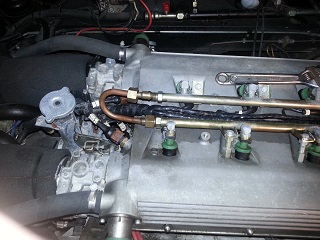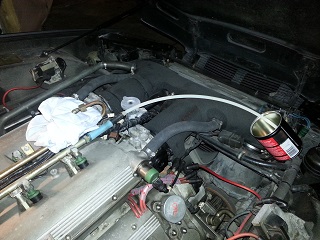Removing water from the Virage petrol tank
Garry has devised a relatively simple and quick method of detecting and removing water from the Virage fuel tank should you be unlucky enough to get some in there. Here are the steps – photos will follow when we next have the lid off. It’s easiest done with two people – no skill is needed for the second person.
1. Remove the aluminium cover from the top of the engine (this covers the fuel rails and injectors).
2. At the front of the fuel rails, you will see a copper u-bend (in 10mm or so copper tube) that is connected to the fuel rails with compression fittings. Take this off, and fit some rubber tubing in its place that leads into a clear glass or plastic bottle.
Click this image for a larger view
3. Now turn over the engine. It will not fire as there will now be no pressure, but the turns will force petrol into your bottle. Check the appearance – if there is water the output will look cloudy. On J*hn’s car it took nearly 20 turns to expell the 6 litres of water that had accumulated in the tank. If the pump runs and then stops before you have expelled all the water, see the note below.
Click this image for a larger view
4. The engine will run faster when it is running on pure petrol as opposed to a petrol/water mix, so that is one way to determine that you are finished. Keep turning till you are done.
Note:
When switching on the ignition the pump should run to pressurize the system. It will probably only run for a limited time as the immobilizer usually cuts it off if the engine has not started.
There should be two wires at the pump, black=earth and white/yellow=live feed. To run the pump continuously connect the white/yellow wire to the battery.
Other useful pages
- Introduction
- The Virage Engine
- Maintaining the Virage engine
- Bodywork
- Removing water from the Virage petrol tank
- Virage relays – one cause of the one-way journey
- Virage immobiliser – the elusive wiring diagram is tracked down
- Virage – fixing cracked vacuum pipes
- Virage radiator sensors – seals and electrical connections –
- Virage Brakes and Suspension joints
- Virage relays in detail – first place to look if you have over-revving or uneven running problems
- Virage reversing lights/start inhibit
- Virage timing chain tensioner and guide replacement
- Virage fuel filler cap fix – stop water getting into the fuel tank.
- Virage water temperature and throttle sensors – a possible cause of overrunning
- Virage – VIC background, and breakthrough in VIC repair
- Virage VIC – restoring the unit to life
- Detailed instructions on fixing the VIC


